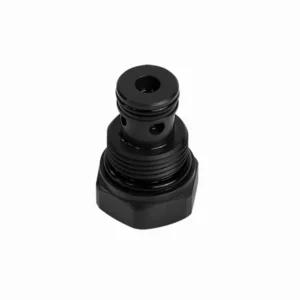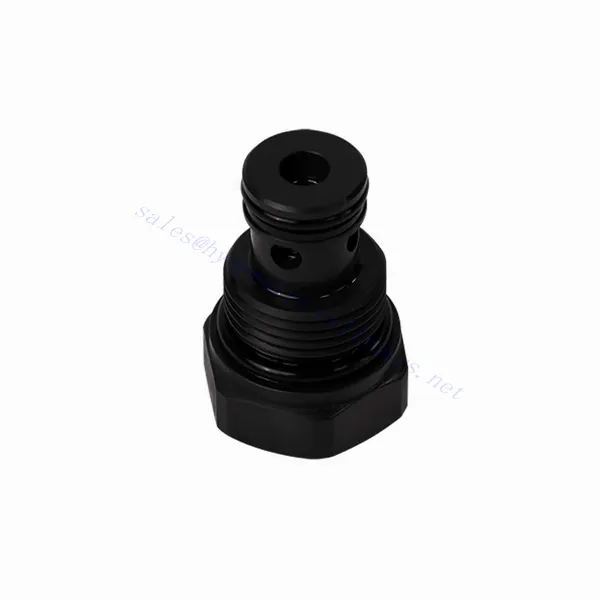RVM Series Check Hydraulic Valve Cartridge
RVM Series Check Hydraulic Valve Cartridge

The RVM series check hydraulic valve cartridge is a reliable and versatile component for optimal fluid control in hydraulic systems. Engineered to ensure efficient and precise regulation of hydraulic flow, this valve cartridge offers exceptional performance, durability, and ease of use.
The RVM series check hydraulic valve cartridge is a reliable and efficient solution for fluid control in hydraulic systems. With its efficient check valve functionality, robust construction, compact design, and high flow capacity, this valve cartridge ensures optimal performance and minimizes the risk of system damage. By following the recommended usage methods and maintenance practices, the RVM series check hydraulic valve cartridge delivers reliable operation and extends the lifespan of hydraulic systems. Upgrade your hydraulic system with the RVM series check hydraulic valve cartridge and experience enhanced fluid control efficiency.
RVM Series Check Hydraulic Valve Cartridge Key Characteristics:
- Efficient Check Valve Functionality:
- The RVM series valve cartridge incorporates a highly efficient check valve mechanism that enables the unidirectional flow of hydraulic fluid.
- It effectively prevents backflow, ensuring smooth operation and minimizing the risk of damage to the hydraulic system.
- 坚固的结构
- Built with high-quality materials, the RVM series valve cartridge is exceptionally durable and resistant to wear, ensuring a long service life.
- Its robust construction enables it to withstand high-pressure environments and demanding operating conditions.
- Compact and Versatile Design:
- The valve cartridge is compact, making it suitable for applications with limited space or weight constraints.
- Its versatile design allows for easy integration into various hydraulic systems, including industrial machinery, mobile equipment, and power units.
- High Flow Capacity:
- Despite its compact size, the RVM series valve cartridge offers high flow capacity, allowing for efficient fluid transfer and optimal system performance.
- It minimizes pressure drops, delivering maximum hydraulic power to actuators and other components.
RVM Series Check Hydraulic Valve Cartridge Parameter:
| Weight | kg | 0.12 |
| Max. operating pressure | bar | 350 |
| Crack pressure | bar | 0.2 0.5 |
| Max. flow-rate | L/min | 30 |
| Viscosity range | mm2/s | Recommandation 30~80, permission 20~380 |
| Fluid temperature range | ℃ | -30 to +80(NBR seal) |
| -20 to +80(FKM seal) | ||
| Fluid | Mineral oil suitable for NBR and FKM seal | |
| Phosphate ester for FKM seal | ||
| Degree of contamination | Maximum permissible degree of fluid contamination: Class 9. NAS 1638 or 20/18/15, ISO4406 | |
RVM Series Check Hydraulic Valve Cartridge Advantages:
• Seal without leakage
• Cartridge structure for oil block installation
Usage Method Of RVM Series Check Hydraulic Valve Cartridge :
- System Analysis:
- Before installation, thoroughly analyze the hydraulic system to determine specific requirements and operational parameters.
- Consider factors like flow rates, pressure ratings, and RVM series valve cartridge compatibility.
- Valve Selection:
- Choose the appropriate RVM series valve cartridge variant based on the system requirements and specifications.
- Consider factors like flow capacity, pressure ratings, and compatibility with other system components.
- Installation:
- Follow the manufacturer’s instructions for properly installing the RVM series valve cartridge in the hydraulic system.
- Ensure a secure fit within the valve cavity, proper alignment with the fluid flow path, and adequate sealing to prevent leaks.
- Fluid Flow Direction:
- Confirm that the RVM series valve cartridge is installed in the correct orientation, allowing for the desired fluid flow direction.
- Align the valve cartridge with the system’s flow path, ensuring proper engagement of the check valve mechanism.
How Does A Hydraulic Flow Control Valve Work?
A hydraulic flow control valve is a device used to regulate and control the speed of hydraulic fluid within a hydraulic system. It allows the operator to adjust the flow rate of the liquid, thereby preventing the speed of hydraulic actuators or controlling the rate of energy transfer. Here’s an explanation of how a hydraulic flow control valve works:
- Valve Structure:
- A hydraulic flow control valve typically consists of a valve body with inlet and outlet ports, a movable spool or poppet, and an actuating mechanism.
- The valve body contains internal passages and chambers that control the flow of hydraulic fluid.
- Fluid Flow Paths:
- The flow control valve has an inlet port that connects to the hydraulic power source, such as a pump, and an outlet port that connects to the hydraulic actuator or another component.
- The valve provides different flow paths for fluid, allowing it to be controlled and regulated.
- Spool or Poppet:
- The valve body houses a movable spool or poppet that regulates the flow of hydraulic fluid.
- The spool can slide within the valve body, while the poppet can move linearly or rotate to open or close specific passages.
- Actuating Mechanism:
- Hydraulic flow control valves can be actuated manually, electrically, or through other means, depending on the specific design and application requirements.
- Manual actuation involves adjusting a handle, knob, or lever to position the spool or poppet.
- Electrical actuation utilizes solenoids that receive electrical signals to shift the spool or poppet, allowing for remote control and automation.
- Valve Positions:
- A hydraulic flow control valve typically has multiple positions that the spool or poppet can assume, each corresponding to a specific flow rate.
- The valve may have a range of preset positions or offer continuous adjustment for fine-tuning the flow rate.
- As the spool or poppet shifts, it aligns with specific passages, opening or closing them to control the fluid flow.
- Flow Regulation:
- By adjusting the position of the spool or poppet, the operator can control the size of the flow passages, thereby regulating the flow rate of the hydraulic fluid.
- When the passages are fully open, the fluid flows freely, allowing for maximum flow rate.
- Partially closing the passages restricts the flow, reducing the flow rate and controlling the speed of hydraulic actuators.
- Pressure Compensation:
- Some hydraulic flow control valves incorporate pressure compensation mechanisms to maintain a consistent flow rate despite changes in system pressure.
- These mechanisms ensure that the desired flow rate is maintained even when the system encounters variations in load or pressure.
工厂的能力和产能:
(1) 装配
我们拥有一流的自主研发装配平台。液压油缸生产车间拥有 4 条半自动提升油缸装配线和 1 条全自动倾斜油缸装配线,设计年生产能力 100 万支。特种油缸车间配备了各种规格的半自动清洗装配系统,设计年生产能力 20 万只,并配备了知名数控加工设备、加工中心、高精度油缸加工专用设备、机器人焊接机、自动清洗机、油缸自动装配机、自动喷漆生产线等。现有关键设备 300 多台(套)。设备资源的优化配置和高效利用,保证了产品的精度要求,满足了产品的高质量需求。


(2) 机加工
加工车间配备了定制的斜轨车削中心、加工中心、高速珩磨机、焊接机器人及其他相关设备,可加工最大内径 400 毫米、最大长度 6 米的气缸管。

(3) 焊接

(4) 油漆和涂料
配备中小型圆筒自动水性漆喷涂线,实现机器人自动上下料和自动喷涂,设计产能为每班 4000 件;
我们还拥有一条由动力链驱动的大型油缸半自动喷漆生产线,设计产能为每班 60 箱。


(5) 测试
我们拥有一流的检验设施和试验台,确保气缸的性能符合要求。

We are one of the best hydraulic cylinder manufacturers. We can offer comprehensive hydraulic cylinders. We also provide corresponding 农用齿轮箱. We have exported our products to clients worldwide and earned a good reputation because of our superior product quality and after-sales service. We welcome customers at home and abroad to contact us to negotiate business, exchange information, and 与我们合作!
参观我们的 VR 工厂
通过以下方式参观我们的 VR 工厂
液压缸应用:


